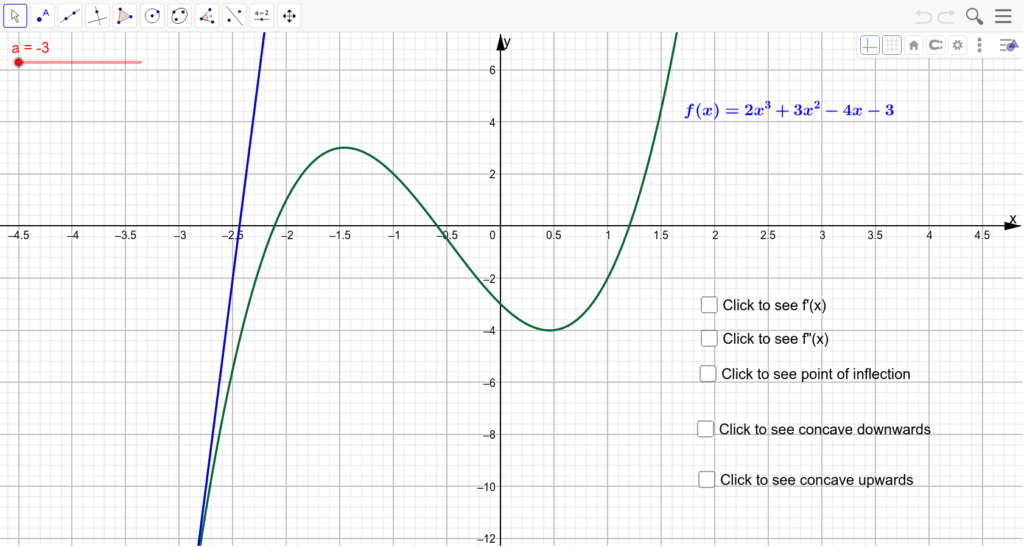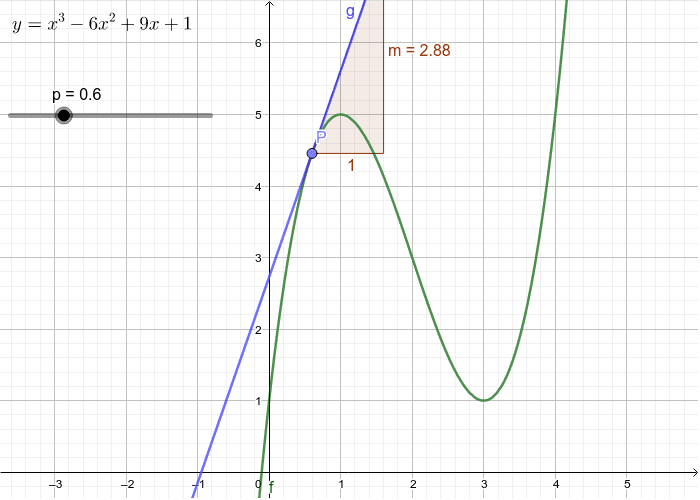A non-stationary point of inflection occurs when the slope of a function, represented by F'(x), is not zero. In simpler terms, it’s a point where the curve changes its bending pattern, but it’s still on the move – there’s no pause with a zero slope. So, if f'(x) isn’t zero, you’re likely looking at a non-stationary point of inflection.
Characteristics of Non-Stationary Points of Inflection:
Non-stationary points of inflection are distinctive features on a function’s graph where the concavity changes. In contrast to stationary inflection points, these points do not coincide with a zero rate of change of the function. Here are the key attributes that define non-stationary points of inflection:
- Second Derivative Test:
- The pivotal characteristic of a non-stationary point of inflection lies in the alteration of the sign of the second derivative (f”(x)).
- A shift from a positive second derivative to a negative one signifies a transition from concave up to concave down, and vice versa.
- No Zero Slope:
- Unlike stationary inflection points, non-stationary inflection points exhibit a non-zero first derivative (f'(x)).
- This implies that the function continues to either ascend or descend at the inflection point, with a reversal in the rate of change (slope) direction.
- Graphical Behavior:
- Visually, a non-stationary inflection point manifests as a smooth transition between two curved segments of the graph, devoid of abrupt corners or cusps.
- Envision a roller coaster track smoothly transitioning from an ascent to a descent, or vice versa.
- Applications:
- Non-stationary inflection points play a pivotal role in diverse fields, such as calculus for analyzing function behavior beyond local extrema, physics to study object motion and engineering for designing structures resilient to varying forces and stresses.
Examples:
Example 1 (f(x) = x^3): This function exhibits a non-stationary inflection point at x = 0, where the second derivative undergoes a shift from positive to negative, signifying a transition from concave up to concave down.
Example 2 (f(x) = sin(x)): The sine function displays non-stationary inflection points at every odd multiple of π/2, where the second derivative changes signs, indicating alterations in concavity.
Mathematical Analysis

Second Derivative Test
1. Review of the Second Derivative Test for Stationary Points
Purpose: The Second Derivative Test is employed to ascertain the nature of a stationary point (maximum, minimum, or point of inflection) on a function’s graph.
Steps:
Find the first derivative (f'(x)) and set it equal to zero to determine stationary points.
- Compute the second derivative (f”(x)).
- Evaluate f”(x) at each stationary point:
- If f”(x) > 0, the point is a local minimum.
- If f”(x) < 0, the point is a local maximum.
- If f”(x) = 0, the test is inconclusive.
2. Extension to Non-Stationary Points of Inflection
Definition: Non-stationary points of inflection are characterized by a change in graph concavity without a zero slope (non-zero first derivative).
Key Point: The Second Derivative Test remains applicable for identifying non-stationary points of inflection by observing changes in the sign of f”(x), even when f'(x) ≠ 0.
Concavity and Convexity
1. Understanding Concave and Convex Regions
- Concave Up: The function’s graph is concave up over an interval if its tangent lines lie below the graph, resembling a cup opening upwards.
- Concave Down: The function’s graph is concave down over an interval if its tangent lines lie above the graph, resembling a cup opening downwards.
2. Analysis of Concavity and Convexity at Non-Stationary Points of Inflection
- Non-stationary points of inflection signify transitions between concave up and concave down regions.
- The second derivative can determine the nature of these transitions:
- If f”(x) > 0, the graph is concave up.
- If f”(x) < 0, the graph is concave down.
Sign Changes in the Second Derivative
1. Sign Change Implications for Points of Inflection
- A change in the sign of f”(x) suggests a potential point of inflection.
- To confirm, check whether the sign change occurs at a non-stationary point (f'(x) ≠ 0) or a stationary point (f'(x) = 0).
2. Application to Non-Stationary Points
Example: The function f(x) = x^3 has a non-stationary point of inflection at x = 0.
- f'(x) = 3x^2, which is non-zero at x = 0.
- f”(x) = 6x, changing sign from positive to negative at x = 0.
Examples and Illustrations of Non-Stationary Points of Inflection
Mathematical Examples
Step 1: Find the second derivative: f” (x) = – 4sin(2x)
Step 2: Look for sign changes in f”(x); f” (x) changes sign from positive to negative at every odd multiple of π / 2 (e.g., π / 2 3π / 2 5π / 2, etc.).
Step 3: Verify that these values make f’ (x) non-zero: f’ (x) = 2cos(2x) is non-zero at all odd multiples of π/ 2
Therefore, the non-stationary points of inflection for f(x) = sin(2x) are at x = π/ 2 , 3π/ 2 ,5π/ 2 etc.
Real-World Applications
- Practical Instances of Non-Stationary Points of Inflection:
- Projectile Motion: Analyzing the trajectory of a projectile, the point of inflection on its velocity versus time graph corresponds to its maximum height, where the direction of its velocity momentarily changes from upwards to downwards.
- Optimization Problems: In various optimization problems, non-stationary inflection points can indicate intermediate stationary points that represent transitions between increasing and decreasing segments.
- Analyzing Real-World Scenarios Mathematically:
- Modeling Population Growth: Constructing a mathematical model for population growth might involve a function with a non-stationary inflection point representing the transition from rapid growth to a slower, stabilizing phase.
- Engineering Design: Optimizing the design of a suspension bridge could involve analyzing the load distribution curve with non-stationary inflection points indicating points of maximum stress transition.
Challenges and Considerations with Non-Stationary Points of Inflection
While delving into the analysis of non-stationary points of inflection provides valuable insights, it is essential to be mindful of the challenges and considerations associated with these points:
Identifying Non-Stationary Points of Inflection:
- Finding sign changes in the second derivative:
- Challenge: Sign changes indicate potential inflection points, but confirming non-stationarity requires additional analysis (checking if F′ (x) ≠0)
- Consideration: A thorough examination of both the second and first derivatives is necessary for a comprehensive understanding.
- Numerical calculations and approximations:
- Challenge: Numerical methods used to find roots of high-order derivatives may introduce inaccuracies, impacting the precise location of points of inflection.
- Consideration: Awareness of potential numerical errors is crucial, especially in functions with intricate derivatives.
- Complex functions and computational challenges:
- Challenge: Identifying and analyzing inflection points in functions with complex derivatives can pose computational difficulties, demanding advanced techniques.
- Consideration: Employing appropriate computational tools and techniques is essential for accurate analysis.
Limitations of Analysis Techniques:
- Local information from the second derivative test:
- Challenge: The second derivative test provides insights within specific intervals but does not guarantee information about inflection points across the entire function’s domain.
- Consideration: Recognizing the localized nature of the test and supplementing with additional analysis when needed.
- Neglecting higher-order derivatives:
- Challenge: Focusing on the second derivative might overlook the influence of higher-order derivatives on the behavior of the function at inflection points.
- Consideration: Considering the impact of higher-order derivatives for a more comprehensive analysis.
- Geometric limitations in visualization:
- Challenge: Visualizing inflection points might be challenging for higher-dimensional functions or complex datasets.
- Consideration: Seeking alternative visualization methods or relying on mathematical analysis to overcome geometric limitations.
Sensitivity to Initial Conditions:
- Chaotic systems and sensitivity:
- Challenge: In chaotic systems with sensitivity to initial conditions, small changes in starting values can significantly alter the location and behavior of inflection points.
- Consideration: Acknowledging the potential for sensitivity and exercising caution in interpreting results, especially in chaotic systems.
- Modeling errors and uncertainties:
- Challenge: Real-world models based on functions with inflection points may be sensitive to inaccuracies in input data or measurement errors.
- Consideration: Understanding and quantifying uncertainties, ensuring robust modeling practices to enhance reliability.
- Uncertainty in complex scenarios:
- Challenge: Modeling real-world phenomena with inherent uncertainty or randomness can introduce challenges in interpreting the location and significance of inflection points.
- Consideration: Emphasizing the awareness of uncertainties and adopting suitable modeling approaches to address complex scenarios.
FAQ’s
Is an inflection point a stationary point?
No,An inflection point isn’t a stationary point; it’s a point on a curve where the curvature changes. Stationary points encompass maximum, minimum, and points of inflection, but inflection points are distinct due to the change in curvature rather than being stationary.
Can there be a point of inflection at a non-differentiable point?
Yes, a point of inflection requires continuity but not necessarily differentiability. For instance, a curve at a point like (0, 0) might have undefined derivatives, yet it can be a point of inflection due to the change in curvature.
When there is no point of inflection?
Even when the second derivative, f”(x), equals zero, it’s possible to have no point of inflection. For instance, in the function f(x) = x^4, where f”(x) is always positive, there’s no point of inflection despite f”(0) = 0.
4.Can you have a point of inflection at an undefined point?
Yes, inflection points can exist at points where the second derivative changes sign, including points where the second derivative is undefined. Checking where f”(x) is either zero or undefined helps identify inflection points.
What are the two types of points of inflection?
Points of inflection can be categorized based on whether f'(x) is zero or nonzero. If f'(x) is zero at the inflection point, it’s termed a stationary point of inflection. When f'(x) is not zero at the inflection point, it’s a non-stationary point of inflection.
Final Words
Inflection points play a crucial role in understanding the behavior of a function. When the slope of the function (F'(x)) is zero, it indicates a potential stationary point of inflection. On the other hand, when the slope is not zero (F'(x) ≠ 0), we encounter non-stationary points of inflection.
Moreover, these points signify moments where the curve smoothly transitions between concave up and concave down, offering valuable insights into the changing nature of the function. Analyzing inflection points enhances our comprehension of how a function bends and provides essential information for applications in various fields, from mathematics and physics to real-world problem-solving and optimization.

